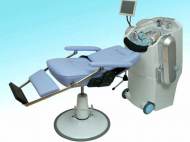Panasonic showcased Roboticbed and hair-washing robot
 Panasonic has been committed to the research and development of robots that assist people, both of those who give and receive health care and welfare services, in order to make everyday living safe, secure and comfortable. They have announced the development of an electric care assistance bed with an integrated wheelchair and a hair-washing robot that drew on the company’s robotics technology.
Panasonic has been committed to the research and development of robots that assist people, both of those who give and receive health care and welfare services, in order to make everyday living safe, secure and comfortable. They have announced the development of an electric care assistance bed with an integrated wheelchair and a hair-washing robot that drew on the company’s robotics technology.
Panasonic unveiled the Roboticbed earlier last year and it works as an electric adjustable bed as well as an electric wheelchair. It is meant to give its users mobility and an extra level of independence while easing the burden of caregivers.
The Roboticbed received a great response from care recipients and givers alike, and Panasonic has been developing safety technologies and guidelines to put robots into practical use in an everyday living environment under a project coordinated by the New Energy and Industrial Technology Development Organization (NEDO), an independent administrative institute in Japan. At the same time, the company has also worked to make the Roboticbed more practical to allow the user to dock the wheelchair into the bed more easily.
Using their expertise in robotics technology, the folks from Panasonic simplified the structure of the new electric care assistance bed by reducing the number of motors and modifying the components. As a result, the user can separate and reunite the bed and the wheelchair more easily, thus reducing the risk and burden associated with the transfer for the user and the caregiver. Adoption of pneumatic support and supplemental wheels also helps the care worker. Voice guidance and LED lights tell the user when the bed is ready to release the wheelchair.
The hair-washing robot uses Panasonic’s robot hand technology. With 16 fingers, the robot washes hair and rinses the shampoo bubbles with the dexterity of human fingers. The robot scans the head and creates a three dimensional image of it. The measures enable it to remember the head shape and apply just the right amount of pressure to each person when shampooing and massaging with its two arms. Each arm has three motors that independently control swing, press and massage motions in conjunction with power detection sensors. The robot even remembers each person’s head shape and preferred massage course.
The hair-washing robot was developed to fill the needs of workers at hospitals and health care facilities. According to Panasonic, the robot will be available to purchase in stores within a few years.









Leave your response!